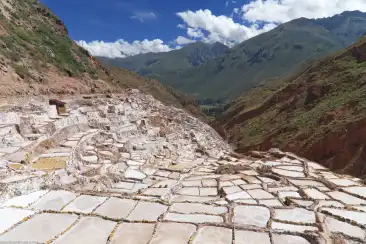Maras

Maras is located 40 kilometers from Cuzco, in the Sacred Valley of the Incas. It is located at 3,375 meters above sea level.
The
Maras salt mine is a place known since time immemorial, and from which
the Incas also benefited. It is worth remembering that the Andes have,
in their geography, an incalculable wealth of flora, fauna and minerals;
and if something was missing for organized societies to lead a life of
privilege, they simply created it or looked for the scenarios where they
could find what they needed.
The salt is dragged by a spring of
temperate water, and directed by a network of small channels that lead
it to the thousands of ponds, where the water rests and by a thermal
process of evaporation leaves the mineral in its soil as residue, soon
to be be picked up There are thousands of ponds where the water is
stored, which carries what was called, by some societies of the past,
"white gold" or "white sand". And in a very ingenious way they continue
to build and restore these ponds that become terraces; being the seasons
the ones that condition its production. Especially in the Andean
winter, it is when the harvest becomes more prosperous, allowing a
selection of its qualities, and after adding iodine it is ready for
consumption. In life, salts are responsible for providing our body with
the necessary minerals, and guaranteeing a good state of health.
Mother
earth blessed those who lived in the sacred valley, giving them salt
flats that sprout from approximately 4 seams of salt water. These were
used by the first inhabitants of these valleys and by the Incas. Here
you can see small constructions made of mud and adobe on the natural
rock. It is also observed how the Incas made a store of that salty stone
that is found on the salt mines that are still preserved today.
Currently, there are around 3,000 salt reservoirs of 5 to 10 square
meters each. The process begins with the filling of each tank every 3 to
4 days when there is enough sun and as soon as they are dry they are
filled with water until there is a height of 10 centimeters of
accumulated salt. The dried salt is then pounded with wood and the first
layer that is scraped off qualifies for human consumption. The second
layer is for animals and the third is for cultivated land.
The origin
of this water remains a mystery that no one has been able to decipher.
It is only known that they have been operating for thousands of years
and that they benefit humble families in the Andes.